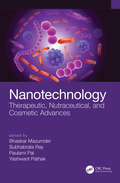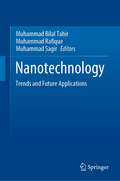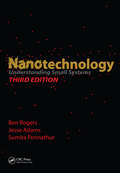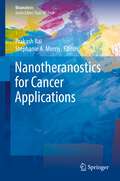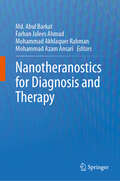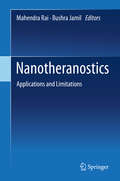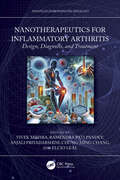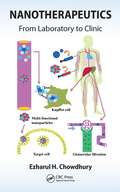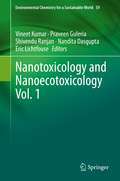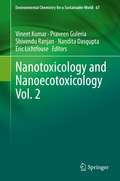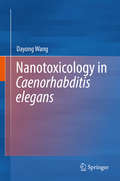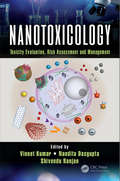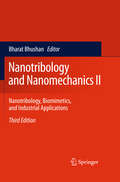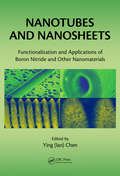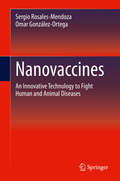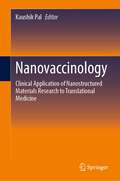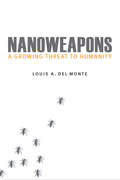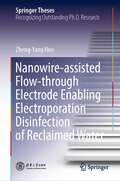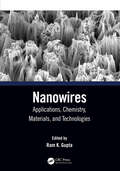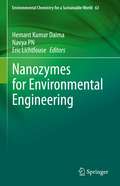- Table View
- List View
Nanotechnology: Therapeutic, Nutraceutical, and Cosmetic Advances (Nutraceuticals Ser. #4)
by Yashwant Pathak Bhaskar Mazumder Subhabrata Ray Paulami PalToday we find the applications of nanotechnology in all spheres of life. Nanotechnology: Therapeutic, Nutraceutical and Cosmetic Advances discusses recent advances in the field, particularly with therapeutics, nutraceuticals and cosmetic sciences. <P><P>Therapeutics is an area which has perhaps benefitted the most, although nanoscience and technology have quietly entered the realms of food science and are playing pivotal roles in the efficient utilization of nutraceuticals. Finally, even before therapeutics came cosmetics and companies started marketing unique products embedding the beneficial and advanced properties enabled by the use of nanostructures. This book highlights trends and applications of this wonderful new technology.
Nanotechnology: Trends and Future Applications
by Muhammad Sagir Muhammad Bilal Tahir Muhammad RafiqueThis book presents the basic and fundamental aspects of nanomaterials, its types, and classifications with respect to different factors. It contains methods of preparation and characterization of unique nanostructured materials. Consisting of six chapters, this book appeals to a wide readership from academia and industry professionals and is also useful to undergraduate and graduate students focusing on nanotechnology and nanomaterials, sustainable chemistry, energy conversion and storage, environmental protection, opto-electronics, sensors, and surface and interface science. It also appeals to readers who wish to know about the design of new types of materials with controlled nanostructures.
Nanotechnology: Understanding Small Systems, Third Edition (Mechanical and Aerospace Engineering Series)
by Ben Rogers Jesse Adams Sumita PennathurAn Accessible, Scientifically Rigorous Presentation That Helps Your Students Learn the Real StuffWinner of a CHOICE Outstanding Academic Book Award 2011"� takes the revolutionary concepts and techniques that have traditionally been fodder for graduate study and makes them accessible for all. � outstanding introduction to the broad field of nanotech
Nanotheranostics for Cancer Applications (Bioanalysis #5)
by Prakash Rai Stephanie A. MorrisThis book is the first to focus specifically on cancer nanotheranostics. Each of the chapters that make up this comprehensive volume is authored by a researcher, clinician, or regulatory agency member known for their expertise in this field. Theranostics, the technology to simultaneously diagnose and treat a disease, is a nascent field that is growing rapidly in this era of personalized medicine. As the need for cost-effective disease diagnosis grows, drug delivery systems that can act as multifunctional carriers for imaging contrast and therapy agents could provide unique breakthroughs in oncology. Nanotechnology has enabled the development of smart theranostic platforms that can concurrently diagnose disease, start primary treatment, monitor response and initiate secondary treatments if required. In oncology, chemotherapeutics have been routinely used. Some drugs have proven effective but all carry risks of adverse side effects. There is growing interest in using remotely triggered drug delivery systems to limit cytotoxicity in the diseased area. This book reviews the use of theranostic nanoparticles for cancer applications over the past decade. First, it briefly discusses the challenges and limitations of conventional cancer treatments, and presents an overview of the use of nanotechnology in treating cancer. These introductory chapters are followed by those exploring cancer diagnosis and a myriad of delivery methods for nanotherapeutics. The book also addresses multifunctional platforms, treatment monitoring, and regulatory considerations. As a whole, the book aims to briefly summarize the development and clinical potential of various nanotheranostics for cancer applications, and to delineate the challenges that must be overcome for successful clinical development and implementation of such cancer theranostics.
Nanotheranostics for Diagnosis and Therapy
by Farhan Jalees Ahmad Md. Abul Barkat Mohammad Azam Ansari Mohammad Akhlaquer RahmanThis book provides an updated account of recent advancements in the field of nanotechnology-based theranostics with special emphasis on their application in the diagnosis and treatment of various types of cancer and neurological diseases. The book is divided into two sections; the first section provides an introduction to the nanoscale theranostics & radiopharmaceuticals. The second section highlights the importance of nanoscale theranostics in disease diagnosis & treatment. It presents the potential of nanotechnology for developing nanomedicine and nanotheranostics for the diagnosis and treatment of a variety of illnesses. Further, the book discusses the usefulness of theranostic nanoparticles in the diagnosis of disease, identification of location, and stage, and in providing information about the therapy response. In addition, the book focuses on the clinical applications of nanomaterial radiolabeling in nuclear imaging of cancer and other illness. Towards the end, the bookexamines the toxicity, regulatory protocols, and future aspects of clinical applications of theranostics. This book is an invaluable source for academicians and industrial scientists working in multiple healthcare fields like pharmaceutical and biological sciences, life sciences, biotechnology, biomedical engineering, and nanobiotechnology.
Nanotheranostics: Applications and Limitations
by Mahendra Rai Bushra JamilThis book is specifically designed to provide information about various nanocarriers currently developed under the emerging field of nanotheranostics for a sustained, controlled, and targeted co-delivery of diagnostic and therapeutic agents. Diverse theranostic applications of nanotechnology and their limitations are also addressed. It integrates nanobiotechnology with theranostic applications. The combined term nanotheranostics has diverse application particularly in chemotherapy and other infectious diseases.Among other topics addressed are antimicrobial resistance, targeting intra-cellular pathogens, viruses and bacteria, chemotherapy, cancer therapeutics, and inflammatory disorders. This interdisciplinary volume is essential for a diverse group of readers including nanotechnologists, microbiologists, biotechnologists, bioengineering and bioprocess industry.
Nanotherapeutics for Inflammatory Arthritis: Design, Diagnosis, and Treatment (Advances in Bionanotechnology)
by Vivek Mishra Anjali Priyadarshini Ramendra Pati Pandey Chung-Ming Chang Elcio LealNanotherapeutics for Inflammatory Arthritis: Design, Diagnosis, and Treatment highlights nanobiotechnology and its therapeutic applications in the field of inflammatory arthritis, the interaction of nanomaterials in the biological systems, and clinical development of nanomedicines. It also covers the discovery of personalized therapeutics, diagnostics, and nanoparticular delivery systems, the role of bioinformatics nanobiotechnology in personalized oncology. The use of nanosensors for the detection and current challenges in the development of personalized medicine is explained including recent nanotechnology-based strategies.Features: Covers all the fundamental information about nanotechnology and inflammatory arthritis. Highlights the interaction of nanomaterials in the biological systems, and the clinical development of nanomedicines for inflammatory arthritis. Explores the discovery of personalized therapeutics, diagnostics, and nanoparticle delivery systems. Reviews the current challenges in the development of personalized medicine as well as translation of nanomedicine with combination therapy. Discusses the toxicology of using nanomedicines and the risks associated with the use of these nanomedicines. This book is aimed at researchers and professionals in nanotechnology, biomaterial, drug delivery, and inflammatory arthritis.
Nanotherapeutics: From Laboratory to Clinic
by Ezharul Hoque ChowdhuryThe emergence of nanotherapeutics is attributable to the integration of nanotechnology, recombinant DNA technology, and synthetic organic chemistry with medicine for treating critical human diseases in a more efficient and specific molecular approach than therapy with conventionally-designed and formulated drugs. Nanotherapeutics: From Laboratory t
Nanotoxicology and Nanoecotoxicology Vol. 1 (Environmental Chemistry for a Sustainable World #59)
by Eric Lichtfouse Vineet Kumar Shivendu Ranjan Nandita Dasgupta Praveen GuleriaThis book discusses the basics of nanotoxicity and gives a detailed account of methods used for toxicity evaluation of nanomaterials. It also gives indepth coverage of the effect of different types of nanomaterials, including organic and inorganic, on various aquatic animals, microorganisms and plants, and outlines recent challenges, regulatory frameworks and advances in nanotoxicity testing.
Nanotoxicology and Nanoecotoxicology Vol. 2 (Environmental Chemistry for a Sustainable World #67)
by Eric Lichtfouse Vineet Kumar Shivendu Ranjan Nandita Dasgupta Praveen GuleriaThis book reviews advances in the toxicity of nanomaterials, with a focus on nanosensors and nanotoxicity testing, biomagnification, biotransformation, nanosafety, genotoxicity, human health and remediation. This is the second volume on Nanotoxicology and Nanoecotoxicology published in the book series Environmental Chemistry for a Sustainable World.
Nanotoxicology in Caenorhabditis elegans
by Dayong WangThis book focuses on the toxicity of engineered nanomaterials (ENMs) and their underlying physicochemical, cellular, physiological, and molecular mechanisms. Further, it covers ENMs’ translocation and their targeted organ toxicology, and discusses chemical and pharmacological strategies used to combat nanotoxicity. Engineered nanomaterials (ENMs) are defined as materials with one or more dimensions of less than 100 nm, and have shown considerable promise in several areas of development. At the same time, the potential toxicity of ENMs for human health and environmental organisms is increasingly attracting attention. In addition to the typical properties of model animals, Caenorhabditis elegans is extremely sensitive to environmental toxicants, which makes it the ideal in vivo assay system for toxicological studies. C. elegans has been widely used in toxicity assessment and toxicological studies of environmental toxicants and stresses. This book provides a comprehensive summary of nanotoxicology research on C. elegans.
Nanotoxicology in Humans and the Environment (Molecular and Integrative Toxicology)
by Jamie R. Lead Shareen H. Doak Martin J. D. CliftThe book covers the area of ‘Nanotoxicology’ but primarily from the point of view of nanotoxicology at the interface with other disciplines including human toxicology; environmental toxicology; characterization, dose and transformations; regulation; public and elite group perceptions; and interactions with innovation.Nanotoxicology in Humans and the Environment is written for researchers in nanotoxicology in academia, industry, government, and research students. Given the rapid development, the maturing of the discipline and its importance in current regulation and industry development (eg REACH, TSCA), the book is very timely.
Nanotoxicology in Nanobiomedicine
by PK GuptaThis book provides that knowledge needed to introduce individuals to the most important research and content on nanotoxicology in nanobiomedicine. Nanotechnology is helping to considerably improve, even revolutionize many technology and industry sectors: information technology, homeland security, medicine, transportation, energy, food safety, and environmental science, among many others. There is an urgent need for a general reference textbook that presents the most recent information on the toxicity and its effects in all these sectors, biomedicine in particular. It includes historical information, nanotoxicology by subject area and or disease, sources of nanomaterials, drug delivery systems and more. Scientists, researchers, and students in all fields that use nanotechnology will find this book essential reading.
Nanotoxicology in Safety Assessment of Nanomaterials (Advances in Experimental Medicine and Biology #1357)
by Henriqueta Louro Maria João SilvaSince its advent, nanotechnologies are considered key enabling technologies that take advantage of a wide array of nanomaterials (NMs) for biomedical and industrial applications generating significant societal and economic benefits. However, such innovation increases human exposure to these substances through inhalation, ingestion or dermal contact raising public health concerns. Furthermore, the NMs’ specific physicochemical properties, that confer them unique beneficial characteristics, can also elicit nano-bio interactions leading to toxicity and concerns for public health. In addition, such properties can be affected by the surrounding matrix, particularly when incorporated in complex matrices such as food products, leading to secondary features potentially more relevant than primary characteristics for determining their toxicological outcome. These nano specific issues raise the question of whether the NMs may produce adverse outcomes that are not accounted for when using conventional toxicological approaches to assess their safety. Such uncertainties about the safety of NMs for human health and the environment may hamper a faster and more widespread exploration of their potentials. In response, the NMs definition has evolved, and nanotoxicology has developed towards new and more integrative approach methods to support regulatory and policy actions. This book provides a perspective on recent developments in the synthesis, application, and characterization of NMs and the related nanotechnologies, focusing on nanotoxicology for their accurate safety assessment early in the product development stage. The use of complex in vitro models, including multicellular systems and organoids, and “omics-based” approaches, such as transcriptomics or epigenomics, have greatly contributed to an in-depth understanding of the cellular and molecular mechanisms behind some NMs toxicity. Such mechanistic knowledge is equally addressed in this book and has set the basis for a predictive nanotoxicology approach building on adverse outcome pathways. In addition, considering the knowledge provided by the above-mentioned approaches, insights into risk assessment, standardization, and regulation of NMs are also included. Incorporating adequate nanosafety assessment early in the life-cycle of NMs will allow the implementation of the safe and sustainable-by-design paradigm enabling safety to keep pace with innovation. Chapters 10 and 15 are available open access under a Creative Commons Attribution 4.0 International License via link.springer.com.
Nanotoxicology: Toxicity Evaluation, Risk Assessment and Management
by Vineet Kumar, Nandita Dasgupta and Shivendu RanjanAs the application of nanotechnology in the myriad disciplines of science and engineering--from agriculture, pharmaceuticals, material science, and biotechnology to sensors, electronics, and mechanical and electrical engineering--brings benefits it also can produce serious threats to human health and the environment that must be evaluated. The unique properties of nanomaterials make them different from their bulk counterparts. In addition to such unique properties, the nanometric size of nanomaterials can invite some detrimental effects on the health and well-being of living organisms and the environment. Thus, it is important to distinguish nanomaterials with such ill effects from nanomaterials with no or minimum toxicity. Nanotoxicology: Toxicity Evaluation, Risk Assessment and Management covers issues such as the basic principles of nanotoxicity, methods used for nanotoxicity evaluation, risk assessment and its management for nanomaterial toxicity with a focus on current trends, limitations, challenges, and future directions of nanotoxicity evaluation. Various experts from different countries discuss these issues in detail in this book. This will be helpful to researchers, educators, and students who are interested in research opportunities for avoiding the environmental and health hazards of nanomaterials. This book will also be useful for industrial practitioners, policy makers, and other professionals in the fields of toxicology, medicine, pharmacology, food, drugs, and other regulatory sciences.
Nanotribology and Nanomechanics I
by Bharat BhushanThe comprehensive reference and textbook serves as a timely, practical introduction to the principles of nanotribology and nanomechanics. Assuming some familiarity with macroscopic tribology, the book comprises chapters by internationally recognized experts, who integrate knowledge of the field from the mechanics and materials-science perspectives. They cover key measurement techniques, their applications, and theoretical modelling of interfaces, each beginning their contributions with macro- and progressing to microconcepts.
Nanotubes and Nanosheets: Functionalization and Applications of Boron Nitride and Other Nanomaterials
by Ying Ian ChenReveals Innovative Research on BN Nanotubes and NanosheetsNanotubes and Nanosheets: Functionalization and Applications of Boron Nitride and Other Nanomaterials is the first book devoted to nanotubes and nanosheets made of boron nitride (BN). It shows how the properties of BN nanotubes and nanosheets have led to many exciting applications where carb
Nanovaccines: An Innovative Technology to Fight Human and Animal Diseases
by Sergio Rosales-Mendoza Omar González-OrtegaThis book provides a compilation of the current developments in mucosal nanovaccines, which are an attractive approach to fight against infectious and non-communicable diseases. Since nanomaterials possess unique properties; many of them have a positive effect on vaccine efficacy when used as antigen carriers and have been applied in vaccinology with significant advances over the past years. This book addresses the methodologies for mucosal nanovaccines synthesis; based on the following nanomaterials: gold, PLGA, silica, and chitosan nanoparticles; as well as nanogels, carbon nanotubes, liposomes, and Virus-like particles. A description of the immunogenic properties of the mucosal nanovaccines is presented, highlighting the improvements achieved with this approach when compared to conventional formulations. Mucosal vaccines constitute the most practical immunization approach since they are easy to administer (promoting patient´s comfort and increasing compliance), allow triggering relevant immune responses at both the site of administration and distant compartments, and thus may protect the main entry portal for pathogens (oral, nasal, and genital mucosae). In this context, the potential of nanovaccines to result in new mucosal formulations in the benefit of global health is analyzed. Covers the synthesis and functionalization of nanomaterials for the development of nanovaccines;Discusses the underlying mechanisms involved in the induction of immune responses through mucosal compartments and the advantages of nanomaterials in the formulation of nanovaccines;Transmits the state of the art for the development of mucosal nanovaccines;Provides routes for the design and evaluation of mucosal nanovaccines;Presents key perspectives for the field of mucosal vaccine development.
Nanovaccinology: Clinical Application of Nanostructured Materials Research to Translational Medicine
by Kaushik PalThis book provides an overview of the cumulative work on a driving force for innovation in medicine and modern healthcare, boosting advances in therapeutics, biosensors, vaccines, and clinical systems. The work presented shows how nanoparticles have been investigated as vaccine adjuvants because they possess chemical and structural properties that improve immunogenicity as well as the use of nanotechnology in the construction of immunization systems that has developed into the field of viral nanovaccinology. The volume highlights potential areas of research, innovation, and development of finished products for future commercialization and significant research exploration through nanoparticles that prove capable of surmounting most of the barriers like toxicity issues, clearance from biological system, DNA instability, and differences in expression systems. The contributing authors review the primary literature on principles, limitations, and recent breakthroughs in nanoparticle-based antigen delivery vehicles, their use in different diseases, the major bottlenecks, and related issues. Highlighting advances in nanoparticle engineering and the understanding of nanoparticle characteristics as well as critical legacy work dome in the field of nanobiotechnology, the book is ideal for a range of researchers and students in the pure and applied sciences devoted to nanomaterials, vaccinology, and translational medicine.
Nanoweapons: A Growing Threat to Humanity
by Louis A. Del MonteNanoweapons just might render humanity extinct in the near future—a notion that is frightening and shocking but potentially true. In Nanoweapons Louis A. Del Monte describes the most deadly generation of military weapons the world has ever encountered. With dimensions one-thousandth the diameter of a single strand of human hair, this technology threatens to eradicate humanity as it incites world governments to compete in the deadliest arms race ever. In his insightful and prescient account of this risky and radical technology, Del Monte predicts that nanoweapons will dominate the battlefield of the future and will help determine the superpowers of the twenty-first century. He traces the emergence of nanotechnology, discusses the current development of nanoweapons—such as the “mini-nuke,” which weighs five pounds and carries the power of one hundred tons of TNT—and offers concrete recommendations, founded in historical precedent, for controlling their proliferation and avoiding human annihilation. Most critically, Nanoweapons addresses the question: Will it be possible to develop, deploy, and use nanoweapons in warfare without rendering humanity extinct?
Nanowire Transistors
by Colinge, Jean-Pierre and Greer, James C. Jean-Pierre Colinge James C. GreerFrom quantum mechanical concepts to practical circuit applications, this book presents a self-contained and up-to-date account of the physics and technology of nanowire semiconductor devices. It includes a unified account of the critical ideas central to low-dimensional physics and transistor physics which equips readers with a common framework and language to accelerate scientific and technological developments across the two fields. Detailed descriptions of novel quantum mechanical effects such as quantum current oscillations, the metal-to-semiconductor transition and the transition from classical transistor to single-electron transistor operation are described in detail, in addition to real-world applications in the fields of nanoelectronics, biomedical sensing techniques, and advanced semiconductor research. Including numerous illustrations to help readers understand these phenomena, this is an essential resource for researchers and professional engineers working on semiconductor devices and materials in academia and industry.
Nanowire-assisted Flow-through Electrode Enabling Electroporation Disinfection of Reclaimed Water (Springer Theses)
by Zheng-Yang HuoThis Ph.D. book develops nanowire-assisted electroporation disinfection technology based on the flow-through porous electrode. The author presents pioneering results on theoretical modeling, experimental realization, and selected applications, showing the novel disinfection mechanism of electroporation guarantees an exceedingly low level of energy consumption. In this regard, three classes of novel dynamic behavior are investigated: (i) The developed nanowire-assisted flow-through electroporation disinfection technology enables great microbial disinfection performance with extremely low voltage (1V), which significantly reduce the formation potential of harmful disinfection by-products during the treatment process. (ii) The nanowire-assisted flow-through electroporation disinfection technology ensures no reactivation/regrowth of inactivated bacteria and meanwhile promotes the gradual death of damaged bacteria during the storage process. (iii) The application of high-frequency AC power supply (106 Hz) ensures the high microbial disinfection efficiency while suppressing the occurrence of electrochemical reactions and extending the electrode lifetime effectively.
Nanowires: Applications, Chemistry, Materials, and Technologies
by Ram K. GuptaThis comprehensive resource covers the fundamentals of synthesis, characterizations, recent progress, and applications of nanowires for many emerging applications. Early chapters address their unique properties and morphology that enable their electronic, optical, and mechanical properties to be tuned. Later chapters address future perspectives and future challenges in areas where nanowires could provide possible solutions. All chapters are written by global experts, making this a suitable textbook for students and an up-to-date handbook for researchers and industry professionals working in physics, chemistry, materials, energy, biomedical, and nanotechnology. Covers materials, chemistry, and technologies for nanowires. Covers the state-of-the-art progress and challenges in nanowires. Provides fundamentals of the electrochemical behavior of various electrochemical devices and sensors. Offers insights on tuning the properties of nanowires for many emerging applications. Provides a new direction and understanding to scientists, researchers, and students.
Nanozymes for Environmental Engineering (Environmental Chemistry for a Sustainable World #63)
by Eric Lichtfouse Hemant Kumar Daima Navya PnThis book reviews the latest developments and applications of nanozymes in environmental science. Protection of the environment is essential because pollution has become a global problem with many adverse effects on life and ecosystems. For that, remediation strategies and techniques have been designed, yet they are limited. Here, the recent development of nanotechnology opens a new vista for environmental remediation. In particular, nanomaterials displaying enzyme-like activities, named ‘nanozymes’, appear very promising for environmental monitoring, contaminant detection, microbial management, and degradation of organic pollutants. Nanomaterials including metallic, metal oxides and carbon-based nanoparticles with nanozymes activities have been synthesized. These nanozymes have similar activities as natural peroxidase, oxidase, superoxide dismutase and catalase enzymes. Nanozymes have several advantages, yet they suffer from several limitations such as low catalytic efficiency, less substrate selectivity, biocompatibility, and lack of engineering of the active sites.
Nanozymes in Medicine (Environmental Chemistry for a Sustainable World #72)
by Eric Lichtfouse Hemant Kumar Daima Navya PnThis book reviews the latest advances and biomedical applications of nanozymes, which are artificial nanomaterials exhibiting enzymatic properties similar to natural enzymes, but with less limitations than natural enzymes. Nanozymes display advantages such as facile synthesis, easy surface modification, improved stability, higher catalytic power, and target-specific binding. Nanozymes containing metals, metal oxides, carbon, and metal sulfide are actually used for cancer therapy, biomolecules sensing, bioimaging, disease diagnostics and diabetes management. The book discloses underlying mechanisms, concepts, recent trends, constraints, and prospects for nanomedicine using nanozymes.
